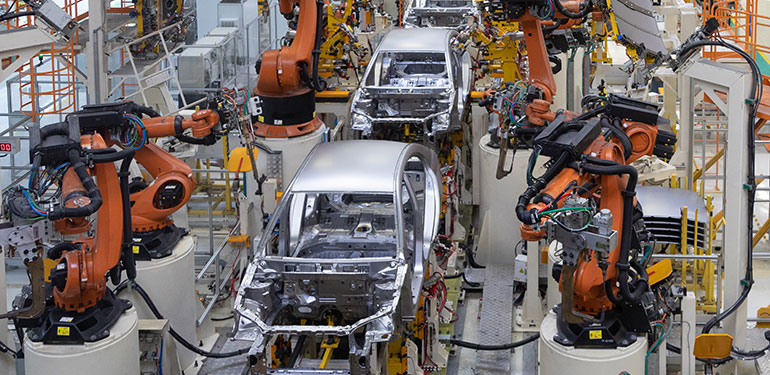Overview / Careers in RoboticsRobotics Careers in Manufacturing
Manufacturing is where robotics of the past meets the robotics of the future. The first successful robots were deployed in factories. These robots followed highly-tuned, pre-planned paths, but manufacturing as a field today is now focused on flexible manufacturing. How fast can an assembly line be changed? Can one robot be used to perform multiple tasks on the line? Can robots interact with humans in a way that both maintains human safety and improves robot performance? The answers to these questions require advances in control, artificial intelligence (AI), and machine learning (ML).
How would a roboticist function in this industry?
This field has long been dominated by industrial robots that have gotten extremely good at following precise and repeatable paths to accomplish a job. In this industry there is now a growing emphasis on robots that work safely with or even augment humans (aka cobots, a term first coined at Northwestern), robots that are more easily integrated into flexible manufacturing processes, and robots that incorporate perception and AI for process automation rather than blindly following a pre-defined path.
How does MSR prepare students for this field?
MSR students develop strong foundations in a wide range of skill sets, including control, AI, and ML, and also become a part of a long line of robotics history. D-H parameters that are the underlying component of all basic robot arm motions were founded at Northwestern in the 1960s. The term cobots was first coined at Northwestern in the 1990s. Today, the program's contemporary research and teaching prepares students to continue evolving how robotics are used within the manufacturing industry.
How is robotics used / applied in this industry?
Robotics are found in manufacturing factories, where they are used in pick-and-place settings, as well as for assembly, welding, and in some cases, painting.
Where our students have interned or our alumni have worked
- BITO Robotics
- DMC Engineering
- Fusion OEM
- HIT Robot Group
- Omron
- Softwear Automation
- Vicarious AI
Featured Alumni

Maurice Rahme
MSR '20, Robotics engineer, Boston DynamicsIn August 2021, "60 Minutes" published a behind-the-scenes look at Boston Dynamics, the company known for releasing viral videos of robots doing backflips and dancing.
In the segment, video of the company's "Stretch" robot is shown as an employee states that warehouses are the next frontier for robotics. "Stretch" is designed to automate moving objects and create more efficient warehouse operations. Maurice Rahme is a controls team engineer on "Stretch," and while he didn't appear on "60 Minutes," his work certainly did. To succeed, Rahme leverages lessons he learned in MSR.
"The main thing I was looking for in a master’s program was a hands-on learning experience," Rahme said. "Theory is important, but it's often difficult to learn without concrete examples, and the skills I've learned through projects have never left me."

Feiyu Chen
MSR '19, Software engineer at Amazon Web ServicesFeiyu Chen works on the Amazon Web Services (AWS) Simple Storage Service (S3), and his daily work is focused primarily on writing code and reviewing others' code.
His responsibilities are to develop an internal web service and tools for AWS that ensures customer data is intact and never corrupted. He frequently finds himself relying on experiences he had while working on the array of required projects in MSR, including in-class assignments as well as his independent and final projects.
"I wrote lots of code during my time in the MSR program, which helped me grow into an experienced programmer who can ramp up quickly on a project and deliver results faster," Chen said. "I also now work with Linux systems every day, and I didn’t know Linux at all until I attended the MSR program."


